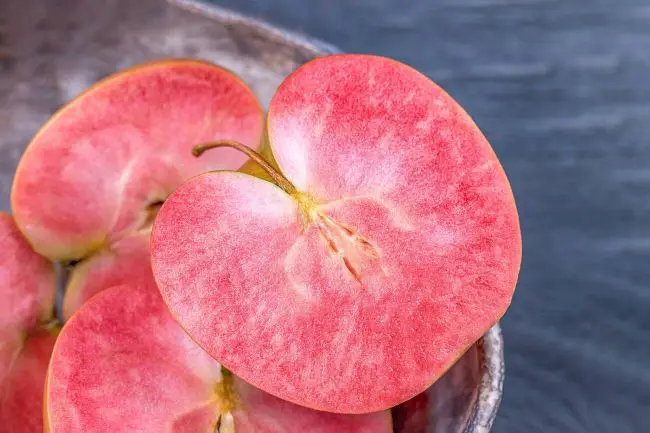Apples are one of the most popular fruits on the planet. They’re sweet, juicy, and crunchy but did you know that some apples actually have pink flesh?
While this isn’t very common, it does happen from time to time. In fact, there are even certain varieties that tend toward having pink flesh inside rather than white.
But why is this happening? And what does it mean when your apple has pink flesh? Let’s take a closer look.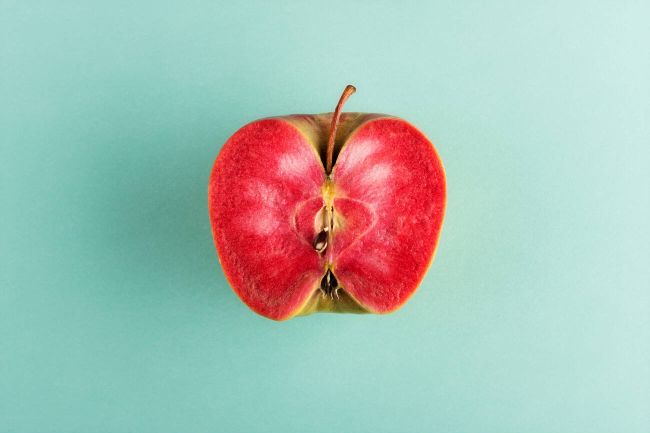
What Causes Pink Flesh in Apples?
Pink flesh in apples is a result of a genetic mutation that causes an excess amount of anthocyanin, which is the red pigment found in apples.
When there are too many anthocyanins present, it turns pink and gives the flesh of an apple its color. A similar occurrence can happen with tomatoes, which sometimes have pink or red coloration on their skin due to a similar genetic mutation.
The amount of anthocyanin in an apple is largely dependent on its variety as well as the growing conditions during which it was produced.
Generally speaking, apples with pink flesh tend to be more tart than those of white flesh, and they tend to have a higher vitamin C content as well.
The pink flesh of an apple is generally considered to be a desirable trait, and it is often used as a marker for certain varieties of apples that are particularly sweet or juicy.
Some people think that pink-fleshed apples taste better than white ones, but this is probably more due to the fact that most people are conditioned to prefer white-fleshed apples over the pink ones than any inherent quality of the fruit itself. Pink-fleshed apples are not better than white ones, they simply have their own unique flavor and texture that many people enjoy.
How does the age of an apple affect its appearance and taste?
Apple trees grow fruit for about five years before they need to be replaced. During each growing season, apples can change in color, size and shape. The skin of an apple is usually green when it is still on the tree, but when it is picked and left to ripen for a few weeks, it will turn red or yellow.
The taste of an apple will also change as it ripens, becoming sweeter and juicier as time goes by. To be sure you’re buying a fresh apple, look for one that’s firm but soft when pressed with your thumb; avoid any apples that are bruised or have soft spots.
If you don’t want to eat your apple right away, store it in the refrigerator. The cold temperature will slow down the ripening process and keep your apple fresh for a long time. If you need to keep it longer than that, wrap it tightly in plastic wrap before placing it back in the fridge.
Apple Pink Inside Common Varieties
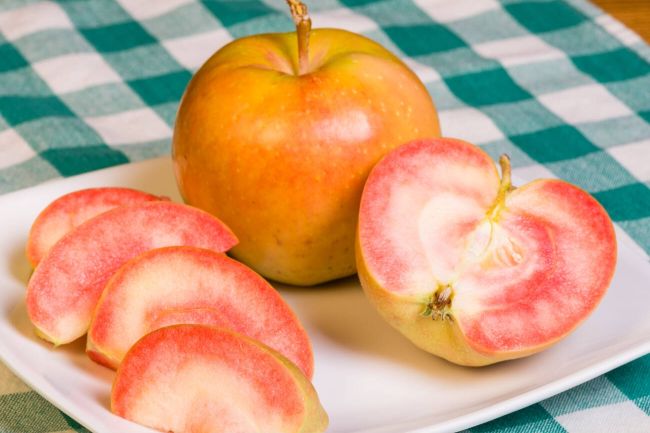
Pink Pearl
Pink Pearl, also known as ‘Pink Lady’, is a pink-fleshed apple variety that originated in California. It was developed by crossing Golden Delicious with a pink-fleshed apple variety.
Pink Pearl is a popular variety for home gardeners because it can be used for fresh eating or cooking, and its flavor has been described as sweet with a hint of tartness. It’s also said to have a crisp texture, which makes it good for eating out of hand. Pink Pearl is suitable for growing in USDA zones 5-10. It’s a relatively hardy variety that performs well in cold climates.
The flesh of this fruit is pinkish red and described as being sweet but firm. The skin has a yellow color when ripe and may have some russeting (brown spots). The apple is best eaten fresh but can be cooked into pies or made into cider.
Thornberry
Thornberry is a delicious red-fleshed apple. It’s the result of years of research by scientists at the University of Guelph in Canada, who crossed two other apples McIntosh and Golden Delicious to create this unique new fruit.
The fruit is sweet and juicy, with a tart tang that makes it a great choice for eating fresh. Thornberry has a deep red color when ripe and the flesh is firm but tender. It’s suitable for growing in USDA zones 4-8. You can find this variety at local orchards in late summer and early fall.
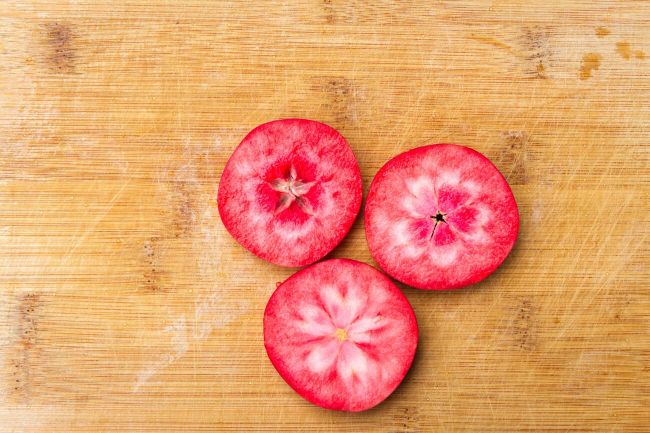
Winter Red Flesh
Winter Red Flesh apples are gorgeous to look at, sweet and delicious to eat. The apples have a bright red skin with yellow striping, and their flesh is also deep red. These apples are a popular variety for baking in the fall because of their sweetness.
Almata
Almata apples are a delicious variety with sweet, juicy flesh that is also crisp and crunchy. This apple is one of the best for eating out of hand, as it has an amazing flavor and aroma.
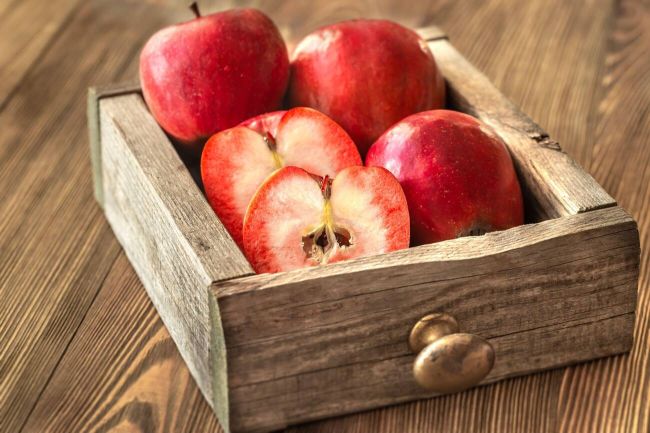
Firecracker
Firecracker is a red-fleshed apple that is small to medium in size and has a firm texture. The apple is best eaten fresh and sweet, with a slight tartness to it.
It’s often used to make salads and other fruit dishes, and it’s great for eating out of hand.
If you have a yard or garden, and are looking for an apple tree that’s easy to maintain and provides delicious fruit, consider growing the firecracker apple tree. These trees also have a beautiful fall colour show.
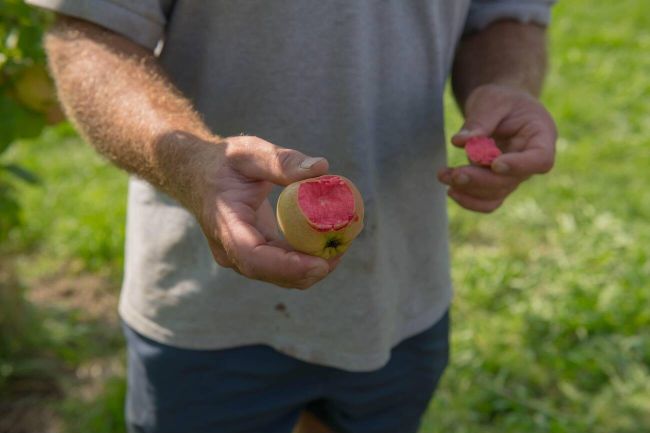
Mountain Rose
Mountain Rose apples are sweet, with a hint of tartness and a crisp texture that makes it great for eating out of hand or adding to salads. Their skin is dark red and they can be stored for several months if you’re willing to keep them around that long.
FAQS
How do I keep my apples from turning brown?
It’s easy to keep apples from turning brown. Once you’ve cut them up or peeled them, just put them in an airtight container or plastic bag and store it in your refrigerator. The same rules apply for whole apples and sliced ones: Store them in the fridge until you’re ready to eat.
Conclusion
Pink apples are not a sign of spoilage, nor are they genetically modified. They’re just a variety of apple that happens to have pink flesh. If you see one, don’t be scare just enjoy!
Also Read: Saskatraz Bees Pros and Cons
